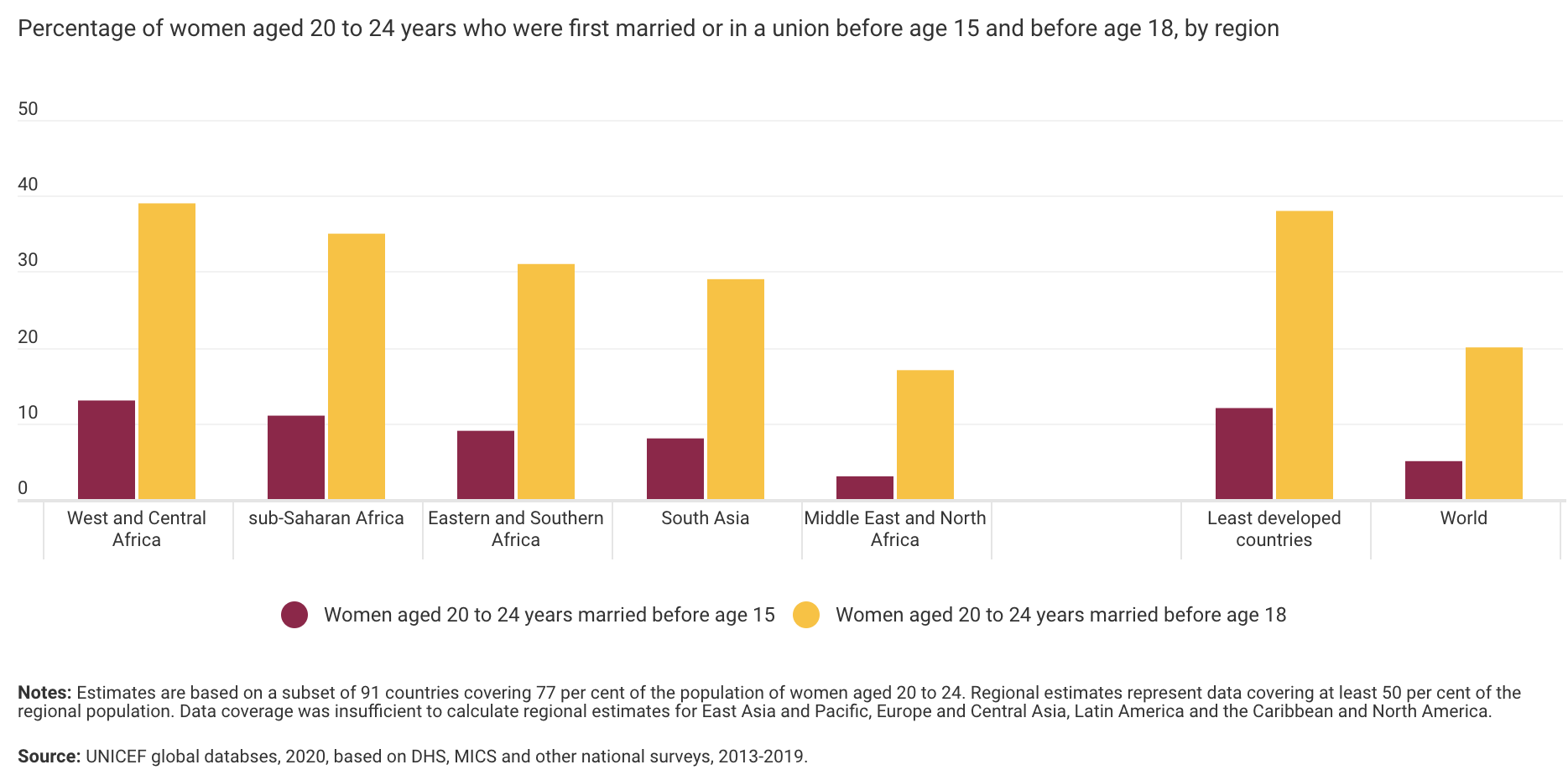Child Marriage
Child Marriage
A staggering 650 million women, who are alive today, were married as children (Girls Not Brides, 2019a). The United Nations International Children’s Emergency Fund (UNICEF) states that “Marriage before the age of 18 is a fundamental violation of human rights” (2020a).
Child marriage is defined as: “any formal marriage or informal union between a child under the age of 18 and an adult or another child” (UNICEF, 2020c).
A Global Problem
Child marriage disproportionately affects girls under the age of 18 more than boys. Globally, 12 million girls are married in childhood per year. Although, encouragingly, this figure has been found to be decreasing. As a whole, child marriage is most prevalent in Africa. The region with the highest levels of female child marriage is West and Central Africa (39%), followed by sub-Saharan Africa (35%), and then Eastern and Southern Africa (31%). Other regions where female child marriage is prevalent are South Asia (29%), and the Middle East and North Africa (19%). Research also shows that female marriage is present within Latin America and the Caribbean, Eastern Europe, and Central Asia (UNICEF, 2020a). The data shows the widespread nature of the issue, which, evidently, is not determined by region or culture.
Child marriage has an incredibly detrimental impact on young girls, and it creates numerous human rights violations. Data shows that 9 out of the 10 countries with the highest rates of child marriage are in some form of humanitarian crisis or fragility. During times of conflict and instability, factors such as gender inequality, poverty, and lack of education can put girls at greater risk of child marriage. Indeed, following the beginning of conflict in Yemen, child marriage increased from 50% to 65% (Girls not Brides, 2018a).
The first major reason for this trend is financial relief. Not only can a price be paid for a bride, but the financial burden on her family is reduced when she leaves their care (Girls not Brides, 2018a).
Furthermore, in times of crisis, girls are at higher risk of being physically or sexually assaulted, and parents view marriage as a way out of this abuse. Unfortunately, oftentimes, this abuse is enacted within the marriage as well. The more blatant use of girls as a commodity is using girls as a ‘weapon of war,’ being sold into prostitution masked as marriage (Girls not Brides, 2018a).
Environmental DisastersInequality and poverty are often exacerbated in times of natural disasters, which result in displacement, limited access to education and healthcare, and societal instability. For example, floods in Bangladesh and northeast India lead to families marrying off their daughters as an alternative to them being in education, which became no longer accessible (Girls not Brides, 2018a).
EducationEducation and access to education has a significant effect on child marriage rates. Girls who have no education are three times more likely to marry under the age of 18 compared to those with a secondary or higher education. In addition to education providing girls with an alternative to being married at a young age, it also provides them with the autonomy to make their own informed decisions by teaching them to be empowered, independent individuals (Girls not Brides, 2019b).
Health ImplicationsThe health impacts of child marriage are severe. Being married at a young age comes with the expectation of bearing children. Many girls’ minds and bodies are not developed enough to be able to, safely and consensually, participate in sexual activity, which is often disregarded due to societal pressure (Girls not Brides, 2018b).
Young brides who become pregnant face great difficulties. The top cause of death, globally, in 15-19-year-old girls is complications during pregnancy. As well as the risk of fatality for the mother, a baby has a 50% higher chance of being stillborn or dying within the first few weeks of life when the mother is under 20 years of age, than those born to an older mother (Girls not Brides, 2018b).
Child marriage also comes with the consequence of an increased risk of contracting sexually transmitted diseases such as the Human Immunodeficiency Virus (HIV), whereby figures show that 5,000 girls and young women contract HIV every week (Girls not Brides, 2018b).
Violence and SlaveryWhilst child marriage is often seen as a way for girls to escape poverty and societal harm, it often proliferates into their marriages. Girls who are married before the age of 15 are found to be 50% more likely to suffer from physical or sexual violence by their husband (Girls not Brides, 2018c).
Children have been found to represent 25% of modern slavery victims, whilst women and girls represent 71%. Indeed, under some circumstances, child marriage is a type of enslavement. The nature of child marriage, through which young girls are stripped of consent, coerced into sexual relations, abused, and denied personal choice can be equated to modern slavery (Girls not Brides, 2018d).
As already touched upon, where girls are sold as a weapon of war, they are often captured and sold as wives or slaves. Examples extremist groups who have carried this out, in order to finance their conflicts and disgrace their enemies, are in Iraq and Syria, where Yazidi girls were sold as brides, as well as the abduction of young girls in Somalia and Nigeria, who were forced into marriages with Islamist fighters (Girls not Brides, 2018a).
Boys suffer tooAlthough more prevalent in girls, child marriage also affects boys. Similar to girls, child marriage is not determined by geographical region for boys, with a global estimate of 115 million under 18 marriages amongst males (UNICEF, 2020a). Child marriage amongst any gender is a violation of human rights. However, the effects that this violation has differ.
When boys are married at a young age, they take on the patriarchal role as the head of the household. This societal expectation that the male should provide for his wife and children from a young age can lead to financial pressures, preventing access to education, and a lack of career progression opportunities (Gastón et al., 2019).
A way outChild marriage does not only pose the immediate threat to human rights through breaching the sanctity of childhood, but perpetuates additional violations, such as of physical and psychological abuse, lack of education, health risks, and more. Programs, such as the United Nations Populations Fund-United Nations Children’s Emergency Fund (UNFPA-UNICEF), and Global Programme to End Child Marriage, are working towards promoting the rights of young women through education and empowerment and through examining the fundamental facilitators which enable child marriage (UNFPA-UNICEF, 2020).
As it stands, the United Nations Sustainable Development Goal to end child marriage would require progress to proceed at 17 times the rate it is currently in order for it to be achieved (UNICEF, 2020b). This should not cause discouragement to organizations such as Child not Bride, however, who continue to campaign for the rights of millions of children.

Article by
Costadina Tsoukala-Steggell

Categories


